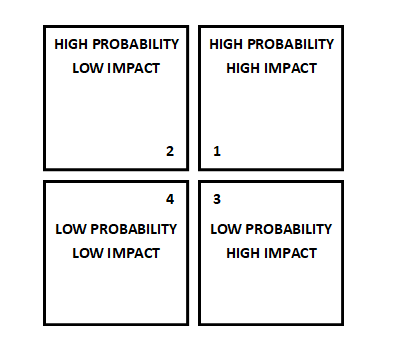
Listen to this Blog Post:
When you are faced with an important decision, how do you evaluate the risk associated with the decision?
Evaluating risk involves assessing the potential outcomes of a decision, considering the likelihood of those outcomes, and weighing their potential impact.
Let me share with you another true story.
As you may know by reading my blog posts and listening to my podcasts, that I have worked as a janitor in a bar. I also worked as a janitor at a grade school which included the grades of kindergarten through six-grade.
During the summer months, one of the big tasks I completed as a janitor at the grade school was to re-paint all the lines on the playground. The playground included numerous hop-scotch outlines, circle outlines for dodge ball, outlines for several basketball courts and outlines for the four-square game.
The four-square game is a popular playground activity that involves four players, a rubber ball, and a square court divided into four smaller squares.
During a four-square game, a player serves the ball into another square. Once the ball bounces into a square, the player who occupies that square must hit the ball into another square with their hands. When a player misses the ball, the player who served the ball scores a point. The game is played up to a desired number of points.
One of the four-square outlines I painted faced east-west. One of the grade school teachers told me when the children played four-square during afternoon recess, the more competitive children always picked the squares on the west side of the square, so the sun was at their back giving them an advantage in the game since the sun was in the eyes of the children on the east side of the squares that were facing west.
Recalling the story of the strategy of these children using the sun during the four-square game made me think about using a simple four-square matrix to evaluate risk for any decision you need to make in your life.
Four Square Risk Management is a simple, but very effective technique used to visually represent and assess risks in a structured manner. It involves using a four-square grid to categorize risks based on their probability and impact. This method helps in identifying which risks require immediate attention and which risks can be monitored over time.
Other researchers have used matrixes for risk analysis.
This is my own interpretation using a four-square matrix. Other researchers may have developed or used something similar in a four-square matrix.
The Four-Square Risk Matrix
- High Probability, High Impact. These are critical risks that are likely to occur and will have a significant impact if they do occur in your life.
- High Probability, Low Impact. These risks are likely to happen but will have a minimal impact if they occur in your life.
- Low Probability, High Impact. These risks are unlikely to occur but will have a major impact if they do occur in your life.
- Low Probability, Low Impact. These are minor risks that are unlikely to occur and will have minimal impact if they do occur in your life.
How do you use the Four-Square Risk Matrix to evaluate risk for a decision you need to make?
- Identify Risks. Make a list of all possible risks for the decision you are making. Evaluate each risk based on its likelihood of occurring. Evaluate the probability such a risk will occur in your life and its potential consequences in your life. Evaluate the impact of taking such a risk in your life. Will the probable consequences be personal, financial, professional, etc. Will the impact in your life be minimal, average, critical, extreme, etc.
- Place the Identified Risks into the Four-Square Matrix. Place each risk you identified in one of the four squares into the Four-Square Risk Matrix based on its identified probability and impact in your life. High Probability, High Impact risks are the most critical risks, Low Probability, High Impact risks are the second most critical risks, High Probability, Low Impact risks are the average risks, Low Probability, Low Impact risks are the minimal risks.
- Create specific Risk Management Strategies for Each Category of Risk. Create a risk action plan for each category of risk you have identified in the Four-Square Risk Matrix. Risk action plans are specific strategies with specific steps designed to handle people, situations and events that could disrupt your risk decisions. To create your risk action plans, ask yourself these questions: What is the final outcome I desire taking this risk? What small and achievable steps can I take each day to achieve this outcome? How is taking this risk going to affect me physically, emotionally, mentally, spiritually, financially, sexually, etc.? Regularly review and update your steps in in your risk action plan as conditions associated with the risk occur and evolve. Such risk action plans provide a predefined course of action for you to take to minimize the impact of these risks for a decision you need to make in your life.
The Four-Square Risk Matrix helps you effectively visualize, prioritize and manage risks so you can create a positive impact in your life.
Out There on the Edge of Everything®…
Stephen Lesavich, PhD
Copyright © 2024, by Stephen Lesavich, PhD. All rights reserved.
Certified solution-focused life coach and experienced business coach.
#risk #riskmanagement #4square #4squareriskmanagement #lesavich
![]()









Add comment